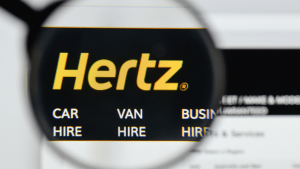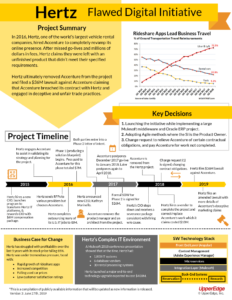- John Belden
- Reading Time: 3 minutes

On June 20th 2019, Hertz filed an amended lawsuit against Accenture and laid out their case on their claim of deceptive and unfair practices. In doing so, Hertz took aim at Accenture talent and trashed the team that was working on the Hertz program.
Background
In April 2019, Hertz filed a lawsuit against Accenture claiming that Accenture breached its contract with Hertz and engaged in deceptive and unfair practices. The claims were made in response to a failed Hertz agile-based digital transformation project.
What We Learned
In its suit, Hertz lays out a five-layer digital platform architecture that it suggests that Accenture recommended:
Front End Layer – The presentation layer in which the screens and the interface were presented to the users using a Javascript framework product called Angular.
Content Management – Adobe Experience Manager (AEM) was to be implemented to allow Hertz to update and revise the content that appeared on the website.
Microservices Layer — Comprised of code that performed various “services,” such as searching for a Hertz location or for a type of vehicle, or writing a review, sending an email to a Hertz representative, etc.
Integration Layer – Mulesoft technology implemented to allow the Hertz front-end systems to request and receive data from the Hertz back-end systems.
Back-End Systems – Hertz’s reservation systems, rewards systems, etc.
Hertz’s New Claims Against Accenture
In its revised suit, Hertz asserts that Accenture represented that they had “the best talent in the world,” “the skills needed to win,” and that they would “put the right team on the ground day one.” Hertz claims that they were far from experts in these technologies and that Accenture was deceptive in their marketing claims. Hertz states the following:
- The front-end developers were not familiar with and did not understand Angular.
- Developers were inexperienced with the AEM code.
- Accenture did not have the skillset they claimed in the use of RAPID, an AEM plug-in tool recommended by Accenture.
- Accenture’s developers also misrepresented the extent of their testing of the code by commenting out portions of the code, so the code appeared to be working.
Hertz claimed they were harmed by these practices in that they had to pay substantial sums to acquire the technology and scrap significant portions of Accenture’s work that was sub-standard and not usable.
What the Future Holds
This is an incredibly important case for any company that will be engaging systems integrators like Accenture, IBM, Deloitte, EY, and others. This case is an early high-profile case in digital transformation using agile-at-scale methodologies. The information available in these suit filings provides insights into how these integrators position themselves in contracts, marketing materials, and how they behave when actively engaged with clients.
The current case docket calls for Accenture to provide its response and defense to the claims in July. UpperEdge will look to harvest intelligence from Accenture’s defense key points that we will be able to use to advise our clients on the risks of digital transformation and what specific contract terms can be used to continue to level the playing field with the big SI’s.
Comment below, follow me on Twitter @jmbelden98 find my other UpperEdge blogs and follow UpperEdge on Twitter and LinkedIn.
Related Posts
Related Blogs
Why You Are Accenture, Deloitte, IBM, and PwC’s #1 Priority—But Not in a Good Way
How Accenture’s Strategy Evolved in 2020
How 25,000 Accenture Layoffs Will Impact Customers
About the Author

